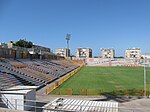HaKiriya Arena
2000 establishments in IsraelBasketball venues in IsraelIndoor arenas in IsraelIsraeli building and structure stubsIsraeli sport stubs ... and 4 more
Middle Eastern sports venue stubsSport in AshdodSports venues completed in 2000Sports venues in Southern District (Israel)

The HaKirya Arena (Hebrew: היכל טוטו הקריה, Heyhal Toto HaKirya) is an indoor sporting arena located in Ashdod, Israel. The arena opened in 2000 and is home for the Maccabi Ashdod and Maccabi Bnot Ashdod basketball clubs. The arena has 1534 permanent seats and 666 seats in removable stands. For basketball games it has a capacity of 2,200, which is reduced to 1534 for handball matches. There are plans to build a 5,000-capacity arena near the "Lakhish park", In the north of the city.
Excerpt from the Wikipedia article HaKiriya Arena (License: CC BY-SA 3.0, Authors, Images).HaKiriya Arena
Sderot Herzl, Ashdod
Geographical coordinates (GPS) Address Nearby Places Show on map
Geographical coordinates (GPS)
| Latitude | Longitude |
|---|---|
| N 31.793537 ° | E 34.64044 ° |
Address
Sderot Herzl
7745258 Ashdod
South District, Israel
Open on Google Maps










